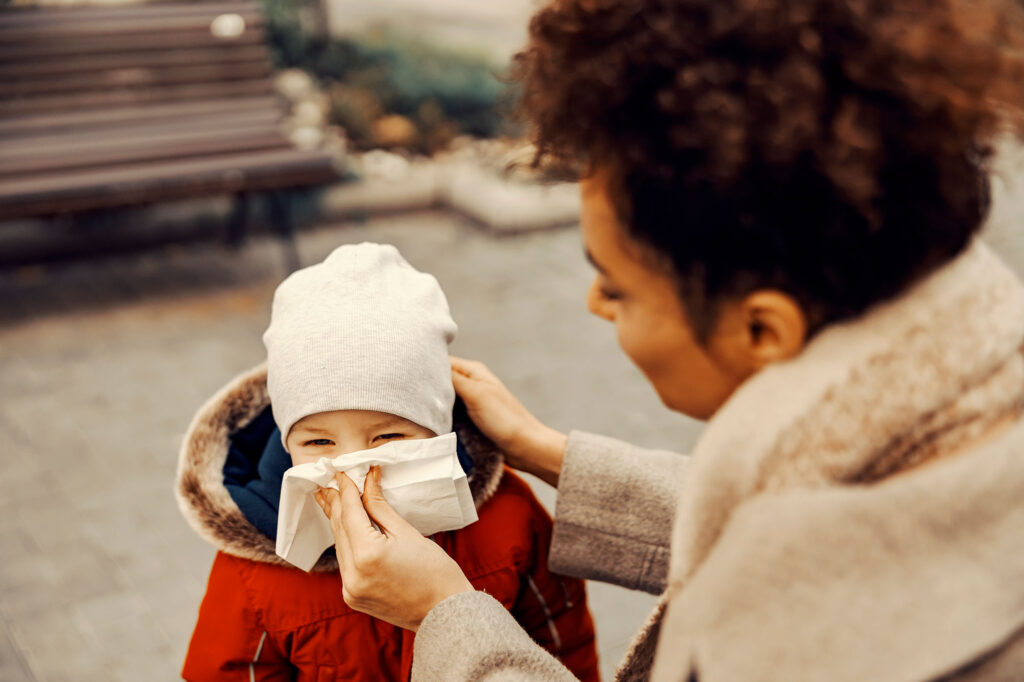We know that no matter what parents do to help their kids stay illness-free (eating well, getting plenty of sleep, and washing hands often), bacterial and viral illnesses are common this time of year.
Don’t forget that our nurse advice line is available to you 24/7 at 503-227-0671. Call us anytime if you need to check in, run the symptoms by us, or learn more about how to keep a sick kiddo comfortable if they fall prey to some of these top 10 winter illnesses in children.
Focus on the power of prevention. The more you do to boost your family’s immune systems, the healthier you’ll be during cold and flu season. While it doesn’t mean you won’t get sick, a healthy immune system suffers less and recovers faster.
1. The common cold (rhinovirus)
The good news for parents is that many of these illnesses, including the common cold, do not require antibiotics or a trip to the pediatrician. Instead, lots of fluids and rest – as well as good nutrition – are key to getting better.
Symptoms of the common cold include:
- Sneezing
- Coughing
- Stuffiness
- Fatigue
Keeping hydrated is essential. Try using herbal teas for cold relief (cooled down a bit for young tongues) since warm fluids help to break up and drain congestion. Humidifiers can also help.
2. Flu (influenza)
The flu vaccine is the first-stop prevention from this highly contagious illness that plagues adults and children. Even if the vaccine doesn’t stop the flu, it will help the illness be milder and take less time to recover and be back to all your normal activities.
Flu symptoms run the gamut from the ones listed for the common cold, but can also include fever, achiness, and fatigue.
Most people can return to work or school five days after the onset of symptoms if they’re feeling better. Rest is essential, and over-the-counter (OTC) children’s flu medications can manage symptoms. Contact our nurse if your child seems worse than usual or has fevers above 103.
3. COVID-19
As you may already be aware, COVID-19 continues to make the rounds. If you haven’t already, ensure your family is up to date on COVID-19 vaccines. We offer these vaccines in the office for patients and parents. COVID-19 tests are available for free from most school districts, and we’re happy to administer a test here. They should stay home for at least five days after the onset of symptoms as long as they feel better. However, we recommend wearing a mask for the next 5 days as you may still be contagious for 10+ days.
COVID-19 Symptoms:
As with the flu, COVID-19 ranges from a sore throat, congestion, and respiratory distress to extreme fatigue and body aches.
4. Respiratory Syncytial Virus (RSV)
RSV can be very serious, particularly in babies, toddlers, and the elderly. This is why RSV vaccinations are so necessary.
We’re seeing an increasing number of patients with RSV here in our offices – and are reading about rising RSV cases nationwide. RSV for most people will be a mild to moderate cold. However, in infants and young children it can cause bronchiolitis. Bronchiolitis can range from mild to severe disease, resulting in some infants being hospitalized for support during the peak of the illness. The RSV immunity shot for infants (newborns through 8 months of age) can decrease the risk of developing severe disease from RSV.
Your child may have RSV if they experience:
- Symptoms of the common cold (listed in #1):
- Wheezing
- Coughing
- Chest congestion
- Decreased appetite
- Difficulty breathing
RSV is very common and rarely becomes serious. Symptoms are typically managed using over the counter medications like acetaminophen. However, call our office if your child has a prolonged fever (72 hours or more) or is struggling to breathe.
5. Chest cold (bronchitis)
So far, the most common colds/flus we’ve mentioned are viruses that don’t respond to antibiotics. Bronchitis is an infection in the larger airways of the lungs that is most commonly caused by a virus and occasionally a bacteria. Usually, it starts with common cold symptoms, but it continues traveling into the respiratory tract, causing severe congestion, productive cough, and potential difficulties in breathing.
Symptoms of bronchitis:
- Achiness
- Chills
- Fever
- Congestion (often with dark yellow or green mucous)
- Wheezing
- Labored breathing
Usually, rest and hydration (along with a humidifier and steamy shower/baths) are enough to do the trick. A bronchitis infection can take three weeks or more to resolve completely. However, sometimes it gets so severe that it becomes walking- or full-blown pneumonia. In that case, your pediatrician may prescribe antibiotics.
6. Pneumonia
Pneumonia is a lower lung infection that can be caused by a virus, like Covid-19 or influenza, or a bacteria. In most young children, it is due to a virus and does not need any antibiotics. Only a trip to the pediatrician can determine which is which.
Symptoms of pneumonia are similar to bronchitis but may also include:
- Higher fevers
- Sweats
- Severely labored breathing (may feel pressure on the chest)
- Sore chest/lungs
Always take your child to the doctor if their symptoms are so severe you even question whether or not they have pneumonia.
7. Pink Eye (Conjunctivitis)
The same bacteria and viruses that cause common colds and flus can infect the eyes. Commonly referred to as pink eye, eye infections are highly contagious, so teaching your children to wash their hands properly and avoid touching their face/eyes helps.
Your child probably has pink eye if their eyes are:
- Red
- Itchy
- Goopy (may even be stuck together when they wake up)
- Light sensitive
- Watery/teary
Keep them home, contact the pediatrician, and we’ll prescribe prescription eye drops depending on if we think the infection is bacterial. In the meantime, sanitizing doorknobs, faucets, and other shared surfaces can help prevent spreading the infection to others in your household.
8. Strep throat
Strep throat is a bacterial infection. It’s highly contagious and typically starts with sore throat and fever without the nasal congestion and cough as seen with the common cold. Your child’s throat will become extremely red, inflamed, and more sore than normal. Some children can barely swallow their saliva, let alone food.
In addition to a very sore throat, children with strep have:
- Fevers
- Aches
- Fatigue
- White spots (pus pockets) on their throat or inflamed tonsils.
- Stomach aches
- Headaches
- May develop a slight rash on their cheeks/chest or red bumps on their tongue (all indicating strep may have become scarlet fever).
Because strep can become serious, we recommend bringing them in for a swab of their throat (called a strep culture). In just a few minutes, we can determine whether or not it’s strep or some other type of bacterial infection and prescribe the correct antibiotics if necessary.
9. Sinus Infection
Some children are more prone to sinus infections than others. It usually develops when a child with extreme stuffiness from a common cold develops an additional bacterial infection in the sinus cavities.
Symptoms of a sinus infection:
- Runny or stuffy nose (with yellow or green discharge) that continues for days.
- Headaches
- Sinus pain
- Fever
- Fatigue
Viral infections that cause sinus infections typically respond well to over the counter medications, while bacterial infections do not. If it’s a bacterial infection, we may prescribe antibiotics. Routine sinus flushing with saline can help keep sinus passages more open, along with hydration and the use of a dehumidifier.
10. Stomach flu (norovirus)
Finally, the age-old stomach flu. Unlike most of the other colds and flu on the list (which can cause stomach upset, especially if a child has postnasal drip) stomach flu symptoms are undeniable.
Symptoms of the norovirus are:
- Irritated and nauseous tummies
- Lack of appetite
- Diarrhea
The stomach flu is highly contagious and likes to lurk on hard surfaces, so keep surfaces (including doorknobs and cabinet door/drawer handles) wiped down with antiseptic wipes. Most of the time, the most severe symptoms clear up within days.
The biggest concern is for babies and toddlers who are quickly dehydrated. Administering small amounts of Pedialyte is a great way to keep all ages hydrated until they can keep food down.
Contact PANW If You’re Concerned About Winter Illness Symptoms In Your Child
Is your child experiencing winter cold and flu symptoms? Does it feel like they’re worse than normal? Never hesitate to contact the Pediatric Associates of the Northwest. That’s what we’re here for! We look forward to helping your family get well!






